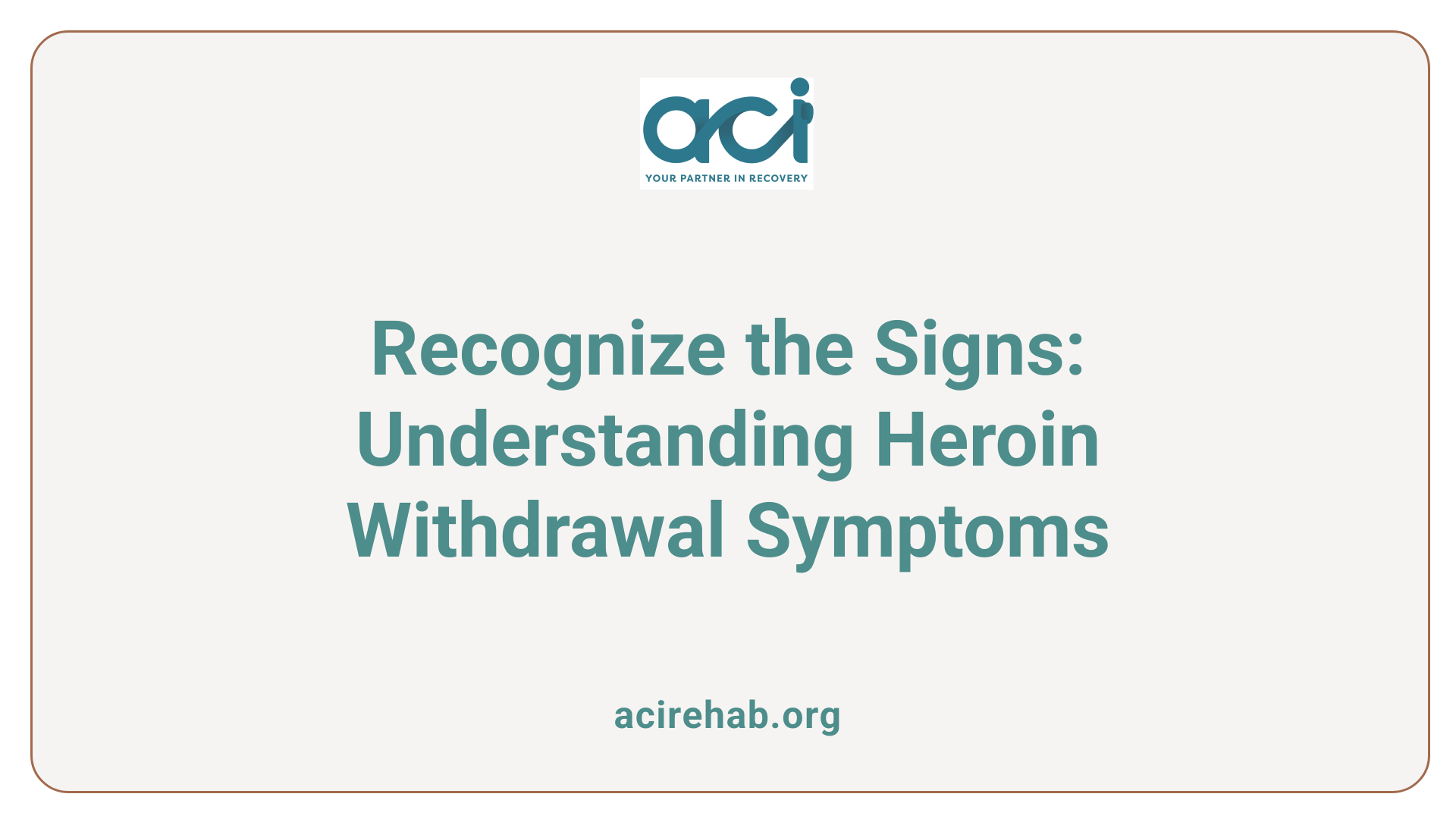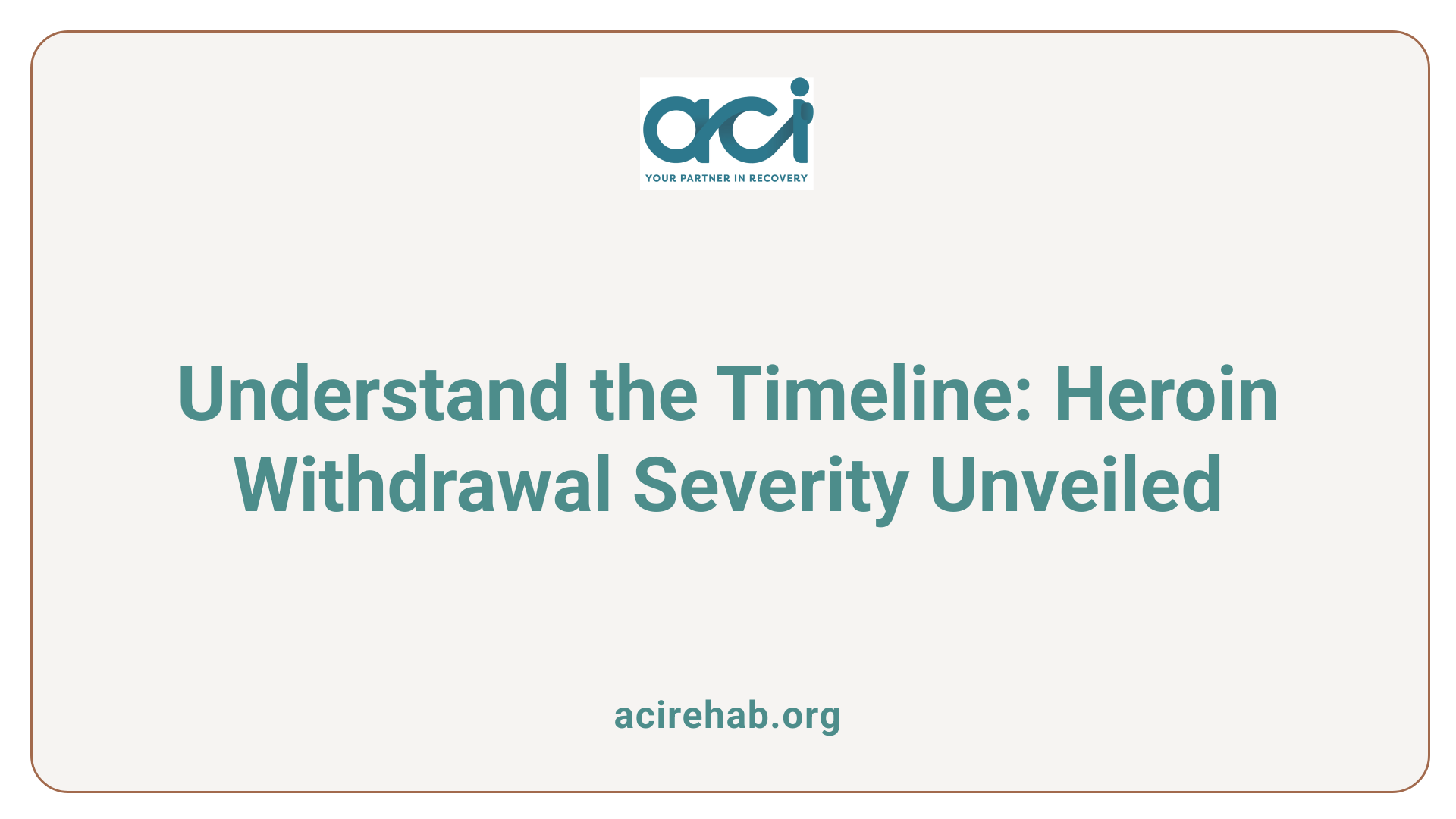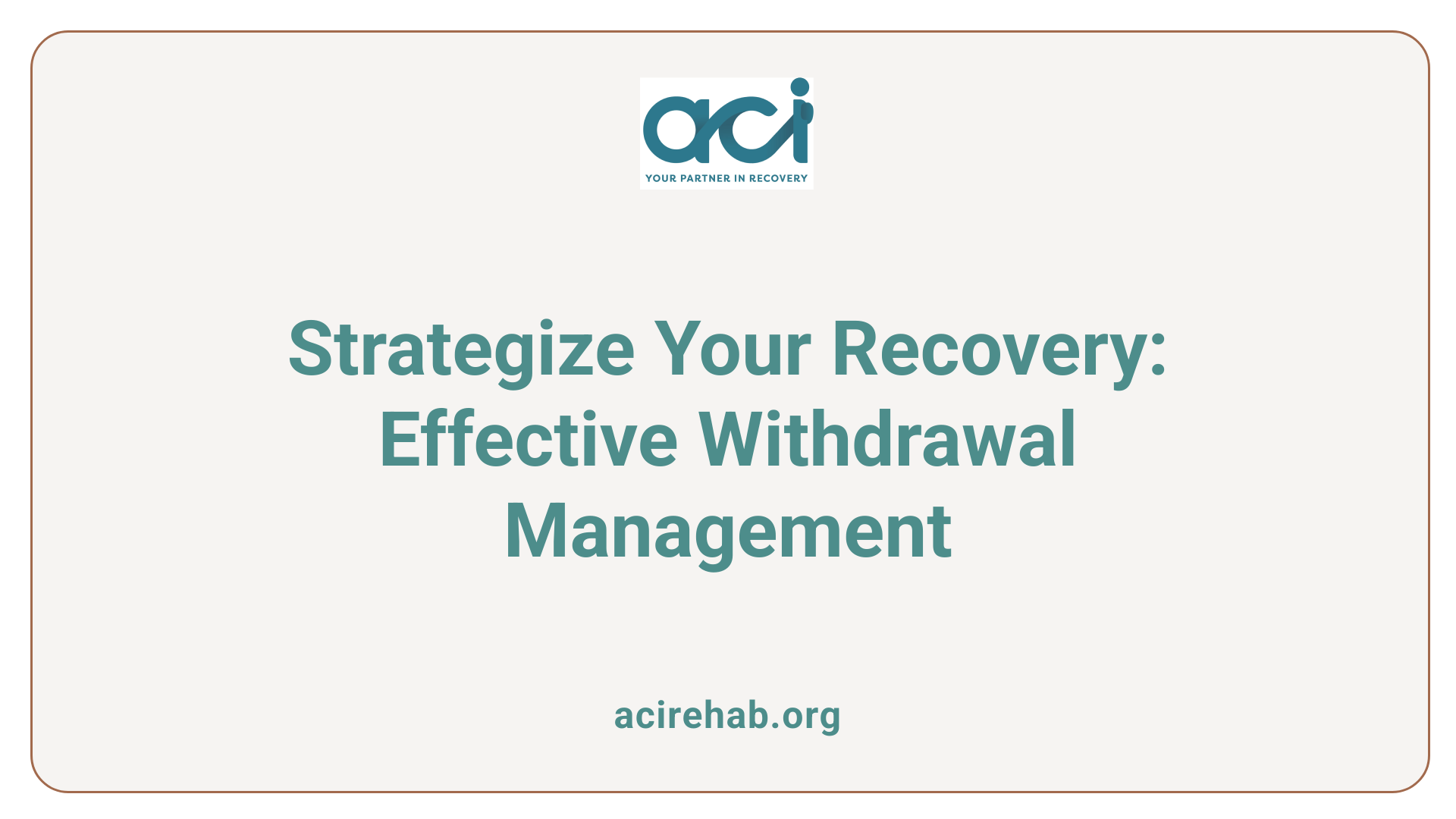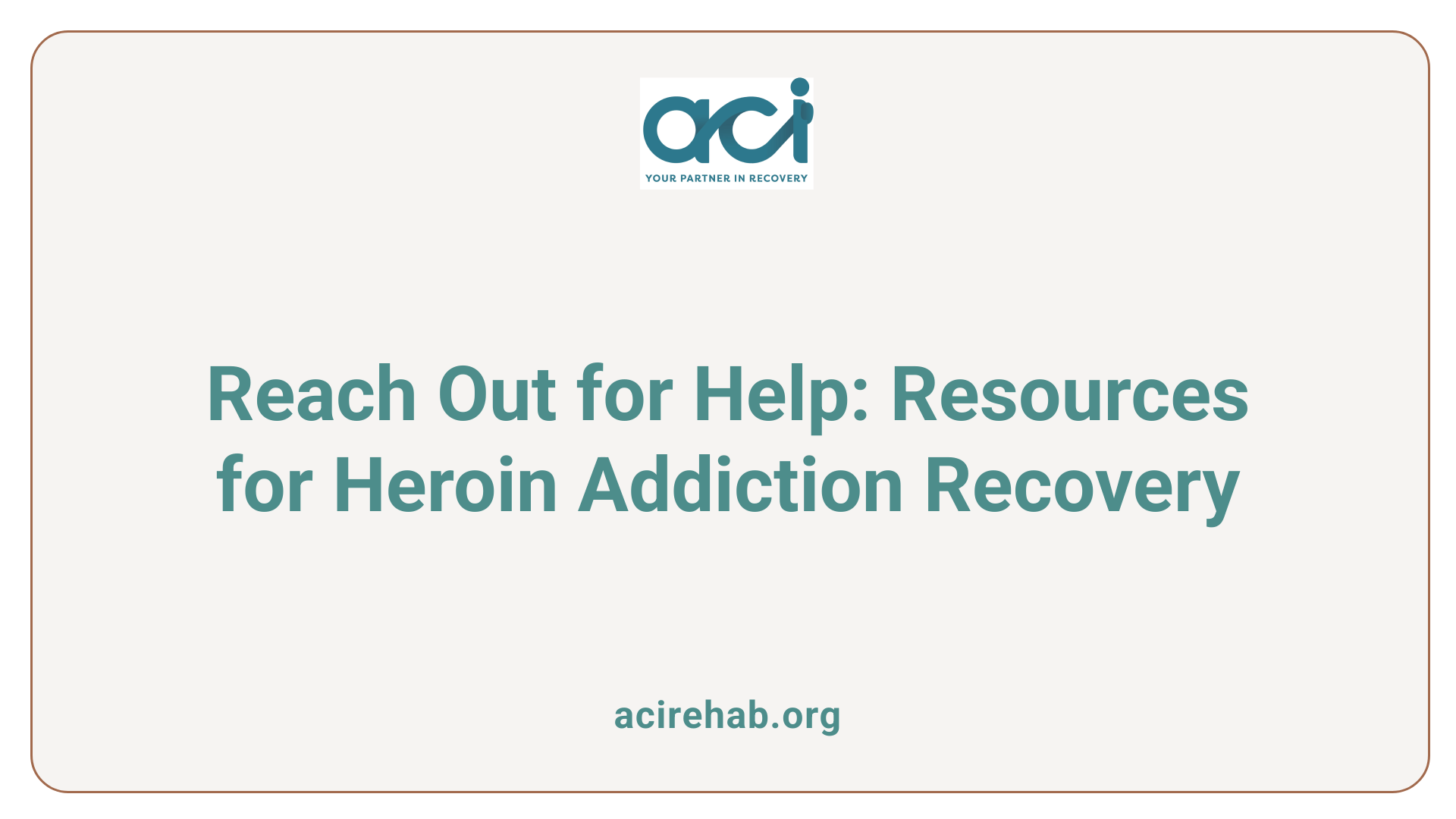Introduction to Heroin Withdrawal
Heroin, an illicit opioid derived from morphine, presents severe addiction challenges worldwide. With over 23% of users becoming habituated, understanding the complexities of heroin withdrawal is crucial. Withdrawal not only manifests physically but also carries significant psychological strains. This article delves into the signs and symptoms of withdrawal, outlines treatment avenues, and explores effective management strategies for overcoming heroin addiction.
Recognizing Signs and Symptoms of Heroin Withdrawal

What are the signs and symptoms of heroin withdrawal?
Heroin withdrawal is a challenging process, often marked by a variety of physical and psychological symptoms. These symptoms typically emerge 6 to 24 hours after the last dose and peak between 48 to 72 hours. This timeline illustrates the acute discomfort that individuals may experience as their body reacts to the absence of the drug.
Common signs and symptoms include:
-
Physical Symptoms:
- Agitation and anxiety
- Muscle aches and bone pain
- Increased tearing and runny nose
- Excessive sweating and chills
- Gastrointestinal distress, including nausea and vomiting
- Dilated pupils
- Abdominal cramps
-
Psychological Effects:
- Intense cravings for heroin
- Mood swings, irritability, and depression
- Sleep disturbances or insomnia
Severe cases may escalate to complications such as increased heart rate, respiratory distress, and in extreme instances, cardiovascular problems or seizures. Monitoring for these symptoms during detox is critical, as they not only inflict suffering but may signal the need for medical intervention to ensure safety and recovery.
For those experiencing these symptoms, it’s essential to consult healthcare professionals for a tailored approach to withdrawal management and support.
The Timeline and Severity of Withdrawal Symptoms

Timeline of heroin withdrawal
Heroin withdrawal typically begins within 6 to 12 hours after the last dose. Initially, users may experience flu-like symptoms such as muscle aches and anxiety. As time progresses, these symptoms intensify, peaking at around 48 to 72 hours. During this peak phase, individuals may encounter more severe symptoms like abdominal cramping, vomiting, and intense cravings for the drug.
The acute withdrawal phase usually lasts for 5 to 10 days. However, for some individuals, especially those who have used heroin for a prolonged period, symptoms may extend well beyond this timeframe, leading to potential post-acute withdrawal syndrome (PAWS) characterized by lingering psychological symptoms.
Factors affecting withdrawal severity
The severity of heroin withdrawal symptoms can vary significantly based on several factors:
- Duration of use: Longer periods of heroin use are associated with more severe withdrawal symptoms.
- Dosage: Higher doses can lead to increased symptom intensity during withdrawal.
- Individual characteristics: Factors such as general health, mental health status, and previous experiences with withdrawal can influence the severity and duration of symptoms.
Additionally, sustained heroin users are at heightened risk for complications like dehydration due to vomiting and diarrhea. This emphasizes the importance of undergoing detox in a medically supervised environment, where healthcare professionals can manage symptoms effectively and provide necessary care.
The Science Behind Heroin’s Effects on the Body

Impact of heroin on the central nervous system
Heroin, a potent opioid derived from morphine, has significant depressant effects on the central nervous system (CNS). When introduced to the body, it rapidly converts to morphine, enhancing its euphoric effects. This transformation leads to immediate feelings of pleasure and relaxation, as heroin binds to opioid receptors in the brain. The impact on the CNS results in slowed breathing, altered heart rates, and reduced pain perception, often referred to as a "high."
Development of dependence and tolerance
Prolonged use of heroin leads to the development of physical dependence. This process is marked by the body adapting to the continuous presence of the drug, resulting in tolerance. Individuals find they need to consume larger amounts of heroin to achieve the same euphoric effects, which compounds the cycle of addiction. When they attempt to reduce or stop their use, withdrawal symptoms arise—as early as 6-12 hours post-use—reflecting the body’s struggle to regain normal functioning without the drug.
Understanding these mechanisms is crucial for recognizing the severity of addiction and the painful withdrawal process that follows cessation.
Withdrawal Management Strategies

What is withdrawal management?
Withdrawal management is a structured approach to facilitate recovery from substance dependence, particularly heroin. It involves medical and psychological support during detox to alleviate withdrawal symptoms while preventing complications, ensuring safety and improving the chances of successful recovery. This process is crucial, as it can ease the discomfort of withdrawal symptoms and help maintain patient health throughout detoxification.
The Role of Medical Detox in Withdrawal Management
Medical detox is fundamentally important in managing heroin withdrawal. It provides:
- 24-Hour Support: Care from healthcare professionals who monitor symptoms and administer medications to ease withdrawal effects.
- Medications: Commonly used medications include buprenorphine and methadone, which help to reduce cravings and associated withdrawal symptoms. These might be paired with other treatments like clonidine for anxiety or metoclopramide for nausea.
- Risk Mitigation: Medical detox helps address severe complications, such as dehydration from vomiting and diarrhea, which can be life-threatening if unmanaged.
- Tailored Approach: Each patient’s management plan is customized based on their unique use history, withdrawal severity, and any potential co-occurring conditions.
This structured environment increases the likelihood of successful recovery by providing comprehensive, compassionate care during this critical phase.
Medications for Managing Heroin Withdrawal
What medications are used to treat withdrawal symptoms in opiate users?
During heroin withdrawal, pharmacological treatments play a crucial role in managing symptoms and improving the recovery process. Common medications include:
- Methadone: A long-acting opioid that alleviates withdrawal symptoms and reduces cravings without the euphoric effects of heroin.
- Buprenorphine: A partial opioid agonist that eases withdrawal symptoms and is often combined with naloxone to prevent misuse.
- LUCEMYRA (lofexidine): A newer medication that targets symptoms like nausea and cramps during the acute withdrawal phase.
These medications offer relief from flu-like withdrawal symptoms and help stabilize individuals during detox.
What new medications are available for opiate withdrawal?
Among the innovative treatments for opioid withdrawal, LUCEMYRA (lofexidine) has emerged. This medication is particularly effective in reducing symptoms such as insomnia and nausea, offering significant relief from Day 2 to Day 3 of the withdrawal process.
It’s essential to note that while LUCEMYRA can significantly alleviate withdrawal effects, it is not a standalone cure for addiction. Instead, it forms part of a comprehensive recovery strategy that may include ongoing counseling and support.
Utilization of these medications allows healthcare providers to customize the treatment plan based on individual needs, ultimately leading to a more successful recovery process.
| Medication | Purpose | Notes |
|---|---|---|
| Methadone | Eases withdrawal, reduces cravings | Long-acting opioid |
| Buprenorphine | Alleviates withdrawal symptoms, prevents misuse | Combined with naloxone |
| LUCEMYRA | Reduces nausea and cramps during withdrawal | Part of comprehensive recovery |
It’s recommended to consult healthcare providers to determine the most effective medication regimen based on specific withdrawal symptoms and individual circumstances.
Coping with Withdrawal: Tips and Recommendations
What are effective tips to help cope with withdrawal symptoms?
Coping with heroin withdrawal can be challenging, but several strategies can aid the recovery process. Seeking medical detox in a supervised environment is crucial, as medical professionals can provide medications like methadone or buprenorphine to alleviate symptoms.
Engaging in regular exercise helps boost endorphin levels, improving mood and reducing anxiety. A balanced diet rich in fruits, vegetables, and whole grains supports overall well-being, while staying hydrated combats dehydration from withdrawal symptoms.
Establishing a routine that includes structured sleep schedules can enhance restfulness, which is often disrupted during withdrawal. Additionally, participation in support groups can offer emotional backing and shared experiences. Mindfulness practices, such as yoga and meditation, also serve to manage stress and anxiety during this difficult time.
Role of support systems in withdrawal
Support systems play a vital role in helping individuals through the withdrawal process. Encouragement from family, friends, or professional counselors can significantly enhance motivation and recovery. Connection to community resources like SAMHSA’s National Helpline can provide further support and referrals to treatment facilities.
Being part of a support group not only fosters a sense of belonging but also allows individuals to share coping strategies and personal experiences, reinforcing the understanding that they are not alone on their journey to recovery.
Support Resources for Heroin Addiction Recovery

Importance of Seeking Professional Help
Seeking professional help for heroin addiction is crucial for successful recovery. Individuals undergoing withdrawal face significant physical and psychological challenges that are best managed in a safe, medically supervised setting. Professional support can prevent complications, such as dehydration and the risk of overdose due to reduced tolerance after detox. Moreover, healthcare professionals can provide medication-assisted treatment, which helps alleviate withdrawal symptoms, making the recovery process more manageable.
Available Resources for Individuals and Families
There are various resources available to support those struggling with heroin addiction. The Substance Abuse and Mental Health Services Administration (SAMHSA) offers a National Helpline (1-800-662-HELP), available 24/7. This confidential service provides referrals to treatment facilities, support groups, and community organizations. The helpline does not require health insurance and can connect users to state-funded programs, making help accessible regardless of financial status.
| Resource | Description | Contact Information |
|---|---|---|
| SAMHSA National Helpline | Free, confidential service for addiction support | 1-800-662-HELP (4357) |
| Text Messaging Service | Send your zip code to 435748 for local assistance | Text HELP4U |
| Local Treatment Centers | In-person care for withdrawal management and recovery | Varies by location |
These resources foster a supportive environment essential for recovery, helping individuals and families navigate the challenges of heroin addiction.
Conclusion: Path to Recovery
Heroin withdrawal is a formidable challenge, marked by significant physical and psychological discomfort. Successful management hinges on understanding the withdrawal process and utilizing medically supervised detox and support structures. By seeking professional help and leveraging available resources, individuals can overcome heroin addiction and improve their quality of life, paving the way for long-term recovery.
References
- Heroin Addiction Withdrawals & Side-Effects Vermilion Behavioral …
- Heroin Addiction Side Effects, Withdrawals, Symptoms & Signs
- National Helpline for Mental Health, Drug, Alcohol Issues – SAMHSA
- Withdrawal Management – NCBI
- Heroin Withdrawal Symptoms, Timeline & Detox for Heroin
- Heroin: Effects, Addiction, Withdrawal Symptoms, and Treatment
- Heroin withdrawal | DACAS
- Opioid Withdrawal – StatPearls – NCBI Bookshelf
- Signs, Symptoms & Effects of Heroin Addiction | Pacific Grove Hospital
- Opioid withdrawal management – SA Health

